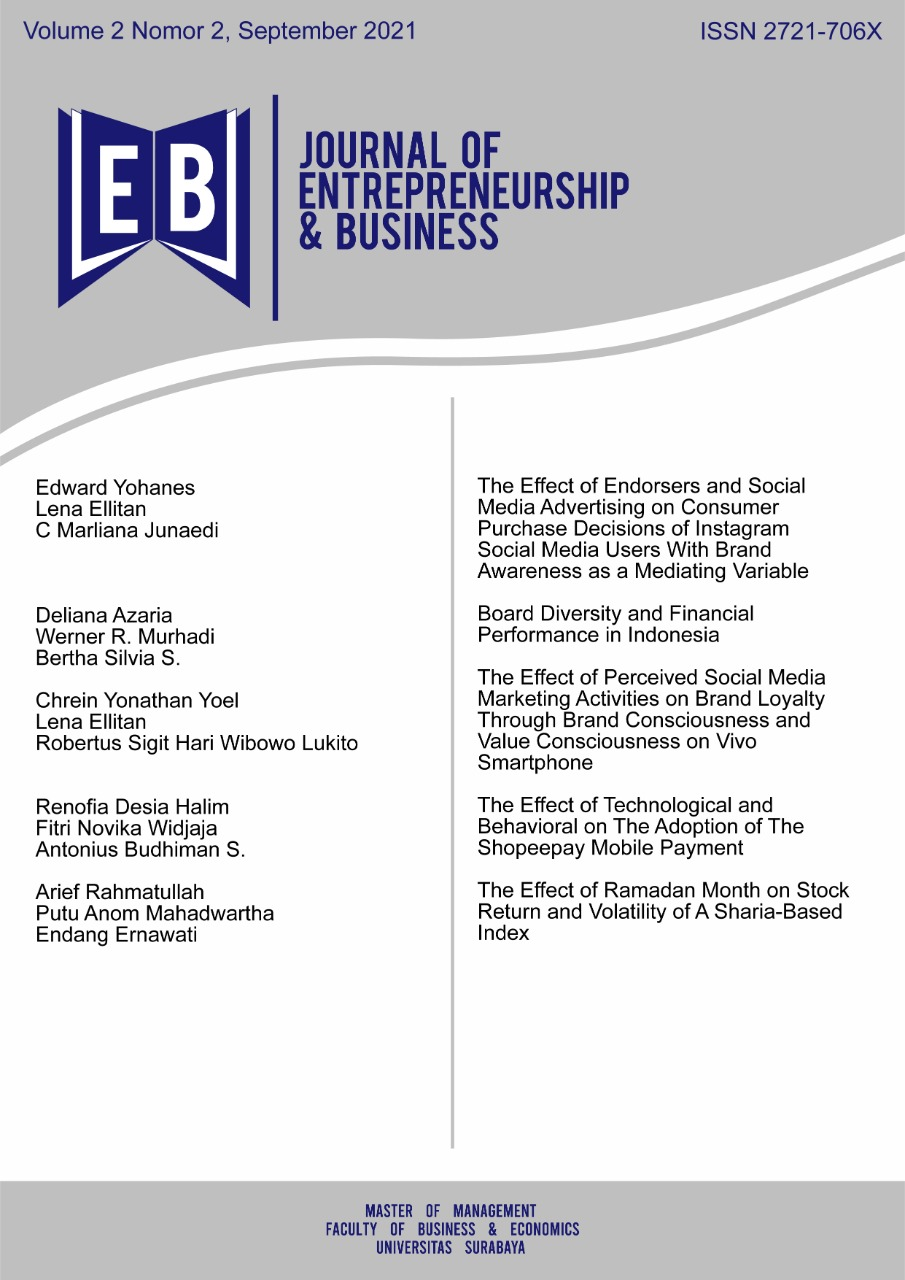The Effect of Technological and Behavioral on the Adoption of the Shopeepay Mobile Payment
 Abstract Views:
810 times
Abstract Views:
810 times
 PDF Downloads:
651 times
PDF Downloads:
651 times
Abstract
This study aims to examine the effect of technological and behavioral attributes on the adoption attributes of the ShopeePay mobile payment application in Indonesia. The application is known as financial technology (fintech), which combines information technology and financial systems. The approach used in this research is a quantitative approach that was processed using SPSS and AMOS. Data collection in this research was done by distributing online questionnaires using a google form to ShopeePay users who used the application in the past month. The results of this study indicate that behavioral intention and social influence variables have an effect on actual use, perceived usefulness and perceived ease of use have an effect on behavioral intention, perceived ease of use and responsiveness have a positive effect on perceived usefulness, and responsiveness and security variables have a positive effect on perceived ease of use, also has a positive effect on social influence.
Downloads
References
Albayati, H., Kim, S. K., & Rho, J. J. (2020). Accepting financial transactions using blockchain technology and cryptocurrency: A customer perspective approach. Technology in Society, 62, 101320.
Annas, M., & Anshori, M. A. (2021). Problematics of Determining Interest in Peer-to-peer Lending in Indonesia. Jurnal Media Hukum, 28(1), 102–117.
Castells, M. (2004). The network society A cross-cultural perspective. Edward Elgar.
Gai, K., Qiu, M., & Sun, X. (2018). A survey on FinTech. Journal of Network and Computer Applications, 103, 262–273.
Gefen, D. (2000). E-commerce: the role of familiarity and trust. Omega, 28(6), 725–737.
Grohmann, A. (2018). Financial literacy and financial behavior: Evidence from the emerging Asian middle class. Pacific-Basin Finance Journal, 48, 129–143.
Gu, J.-C., Lee, S.-C., & Suh, Y.-H. (2009). Determinants of behavioral intention to mobile banking. Expert Systems with Applications, 36(9), 11605–11616.
Hair, J. F. (2009). Multivariate data analysis (7th ed.). Upper Saddle River: Prentice Hall.
Hsueh, S.-C., & Kuo, C.-H. (2017). Effective matching for P2P lending by mining strong association rules. Proceedings of the 3rd International Conference on Industrial and Business Engineering, 30–33.
Isaac, O., Aldholay, A., Abdullah, Z., & Ramayah, T. (2019). Online learning usage within Yemeni higher education: The role of compatibility and task-technology fit as mediating variables in the IS success model. Computers & Education, 136, 113–129.
Pavlou, P. A. (2003). Consumer acceptance of electronic commerce: Integrating trust and risk with the technology acceptance model. International Journal of Electronic Commerce, 7(3), 101–134.
Peter, J. P., & Olson, J. C. (2008). Consumer Behavior and Marketing Strategy, McGrawHill. Boston: McGraw Hill.
Purwianti, L., & Tio, K. (2017). Faktor-faktor yang mempengaruhi behavioural intention. Jurnal Manajemen Maranatha, 17(1), 15–32.
Sastiono, P., & Nuryakin, C. (2019). Inklusi keuangan melalui program layanan keuangan digital dan laku pandai. Jurnal Ekonomi Dan Pembangunan Indonesia, 19(2), 242–262.
Senyo, P. K., & Osabutey, E. L. C. (2020). Unearthing antecedents to financial inclusion through FinTech innovations. Technovation, 98, 102155.
Singh, S., Sahni, M. M., & Kovid, R. K. (2020). What drives FinTech adoption? A multi-method evaluation using an adapted technology acceptance model. Management Decision.
Suryono, R. R. (2019). Financial technology (fintech) dalam perspektif aksiologi. Masyarakat Telematika Dan Informasi Jurnal Penelitian Teknologi Informasi Dan Komunikasi, 10(1), 52.
Teo, A.-C., Tan, G. W.-H., Ooi, K.-B., & Lin, B. (2015). Why consumers adopt mobile payment? A partial least squares structural equation modelling (PLS-SEM) approach. International Journal of Mobile Communications, 13(5), 478–497.
Venkatesh, V., Thong, J. Y. L., & Xu, X. (2012). Consumer acceptance and use of information technology: extending the unified theory of acceptance and use of technology. MIS Quarterly, 36(1), 157–178.
Zhou, T. (2013). An empirical examination of continuance intention of mobile payment services. Decision Support Systems, 54(2), 1085–1091.

This work is licensed under a Creative Commons Attribution 4.0 International License.
Articles published in Journal of Entrepreneurship & Business are licensed under a Creative Commons Attribution 4.0 International (CC BY) license. You are free to copy, transform, or redistribute articles for any lawful purpose in any medium, provided you give appropriate credit to the original author(s) and the journal, link to the license, and indicate if changes were made.
Authors submitting to this journal agree to make their work freely available under the CC BY 4.0 license, ensuring broad dissemination and reuse. The full license details can be accessed at https://creativecommons.org/licenses/by/4.0/.
This ensures that they receive the maximum dissemination because there are no barriers to access. This license allows readers to disseminate and reuse the paper, but always requires them to grant the authors and the first publication full credit.
While JEB upholds ethical publishing standards, the responsibility for ensuring originality and compliance with copyright regulations lies with the authors. The journal is not liable for any legal claims related to the content of published articles.
For further inquiries, please contact the editorial team.

 DOI:
DOI:











